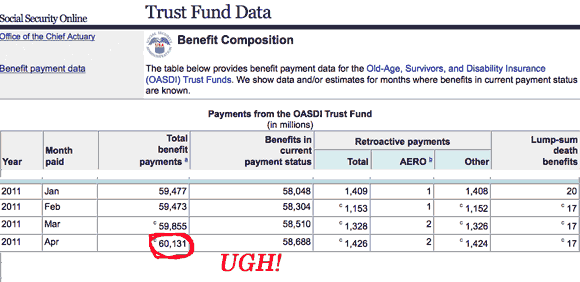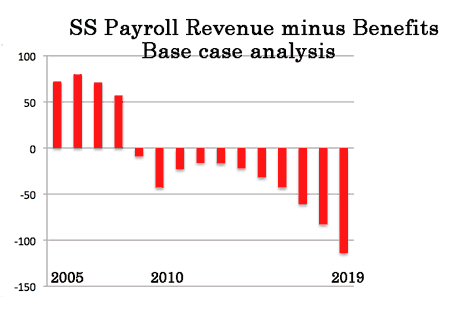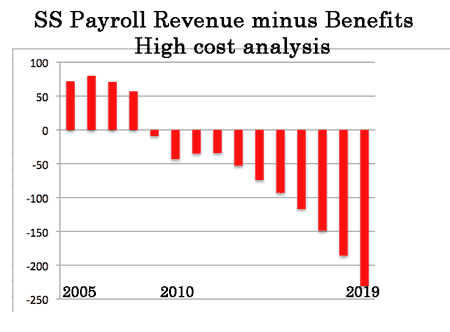
Social Security had its 75th birthday last year. A more important event will take place in April of 2011. That will be the first month that Social Security benefit payments hit $60 billion. Think of that. $60b a month is one hell of a lot of money. This payout (annualized) is approximately equal to the entire GDP of the Netherlands, Turkey or Indonesia. It is 50% higher than the entire economy of Switzerland.
SS first hit the $50 billion mark in December of 2007. It took 42 months to add another $10b to the monthly payout. The next ten billion will come more quickly. The “base case” assumption by the Social Security Trust Fund puts that at October of 2013 (31 months). Their more pessimistic or “high cost” estimate suggests we could hit the $70b mark as early as March of 2012 (23 months).
Of course this never stops rising. The SSTF expects that the $100 billion a month level will be reached in 2019 (base case) and as early as 2017 should the ‘high cost’ scenario play out.
Things really look bad for SS when you consider the revenue numbers from payroll taxes. This chart tracks past and projected pay roll tax revenue versus benefits (based on the Trust Fund’s Base Case)

The High Cost analysis is even worse. For what it is worth, I see almost no chance that the ‘high cost’ will be achieved. It’s going to be even worse than this:

The 2011 – 2019 projected cumulative shortfalls between payroll taxes and benefits are as follows:
Base Case Deficit…..411 billion
High Cost Deficit…..972 billion
There is a pretty serious debate going on in Washington about what to do with SS. At 6% of GDP and 20% of the budget SS has to come on the table. There are many in this discussion that hold to the belief that SS can’t be touched.
If the budget deficit outside of SS was at 3% and the medium-term outlook was for sold GDP growth (with low inflation) the USA could possibly afford the economic cost that SS is about the bring to bear. But sadly, that is not the situation we are looking at. Outside of SS, the country will produce deficits of 10% of GDP and will require Trillions of new debt annually.
It is important to remember that every dollar of deficits at SS requires a dollar of additional debt to be held by the public. The defenders of SS keep looking at something called a Trust Fund that was supposed to “pay” for all of the SS red ink. But the defenders fail to understand that drawing down the Trust Fund just means that we go deeper in the hole on Debt Held by Public.
The Paul Krugmans and Dean Bakers of this debate have held to the position that the amount of debt the country issues on an annual basis is not a metric to seriously consider. They think that the funding deficit resulting from the real economy and at Social Security doesn’t matter.
I think they are wrong. If we wait 2 or 3 more years to wake up to the realities of funding SS, the cost of addressing the problem will be significantly higher. Failure to take this beast on today will probably result in substantial cuts in payouts for all beneficiaries in the not too distant future. That would be the worst possible outcome for the Krugmans and Bakers. For the life of me I can’t understand why these guys don’t see what’s coming. The history books may well say that the staunchest defenders of SS were responsible for it’s demise.
- Bulenox: Get 45% to 91% OFF ... Use Discount Code: UNO
- Risk Our Money Not Yours | Get 50% to 90% OFF ... Use Discount Code: MMBVBKSM
Disclaimer: This page contains affiliate links. If you choose to make a purchase after clicking a link, we may receive a commission at no additional cost to you. Thank you for your support!



6o billion a month! good god almighty,fed better start investing in more presses, it’s gettin almost surreal